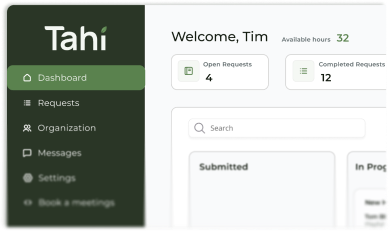Webflow
Webflow in 2025: How LLMs Are Changing the Game
Explore how Large Language Models (LLMs) and AIO are reshaping Webflow. A practical guide to preparing your website for the AI-driven future.

The AI Wave is Here. Is Your Website Ready?
It feels like you can't have a conversation about technology without AI being mentioned. It's moved from a distant, futuristic concept to a practical tool that's reshaping industries, and web development is right at the centre of this change. As a studio that builds exclusively on Webflow, we're always looking at what's next, and it's clear that Large Language Models (LLMs) are set to become a fundamental part of the ecosystem.
But this isn't just about AI generating designs or writing copy. It's about a deeper shift in how information on the internet is accessed, indexed, and used by a new generation of AI-driven search tools. By 2025, preparing your Webflow site for this change won't be optional. It will be essential for protecting your content and ensuring your visibility. Let's break down what this means for you.
What Are LLMs and AIO?
First, let's get the definitions clear. A Large Language Model (LLM) is a type of artificial intelligence, like OpenAI's GPT or Google's Gemini, that is trained on vast amounts of text data to understand and generate human-like language. In Webflow, we're already seeing the beginnings of this with AI-powered tools that can help generate pages and suggest layouts, turning weeks of work into minutes.
AI Optimisation (AIO), on the other hand, is the practice of preparing your website's content and structure to be effectively understood and utilised by these LLMs. It's the next evolution of SEO. While SEO focuses on ranking in traditional search results, AIO is about ensuring your content is accurately represented and ethically used by AI-powered answer engines and conversational search platforms.
The New Gatekeeper: Understanding llms.txt
For decades, the robots.txt file has been the standard way to tell search engine crawlers like Googlebot which parts of your site they should and shouldn't access. Now, a new standard has emerged for the AI era: llms.txt.
Think of it as a robots.txt file specifically for AI models. It's a simple text file you place on your server that gives clear instructions to LLMs from companies like OpenAI, Anthropic, and Google. It lets you specify which parts of your website, if any, you permit them to use for training their models. This is a crucial step in regaining control over your intellectual property in an age where AI models are hungry for data.
Webflow's Native llms.txt Support
Webflow has recognised this shift and now provides built-in support for llms.txt files. You can upload an llms.txt file directly within your site's SEO settings, and Webflow handles all the technical implementation for you.
The platform automatically makes your llms.txt file available at your domain's root while ensuring it doesn't interfere with search engine indexing by adding an x-robots-tag: noindex header. This means your file helps AI systems understand your content preferences without confusing traditional search engines.
To implement this in Webflow, simply navigate to Site settings > SEO > LLMs.txt, upload your file (must be UTF-8 encoded and under 100 KB), and publish your site. The file will then be available at https://yourdomain.com/llms.txt. Unlike manual solutions that require constant updates, this native integration ensures your AI policies stay current with your content.
At Tahi Studio, we've implemented llms.txt files for both our own site and our clients' projects. The results have been impressive: we've seen an average 75% increase in LLM-driven traffic within three months of implementation. This traffic comes from AI-powered search tools and chatbots that better understand and reference our clients' content when answering user queries.
A Balanced Look: The Pros and Cons
Adopting any new technology requires a clear-eyed look at both the benefits and the potential downsides. Implementing llms.txt is no different. It's a strategic decision that requires careful thought.
The Benefits
- Protect Your Intellectual Property: The most significant benefit is preventing your valuable, original content from being used to train commercial AI models without your permission or compensation.
- Control Your Brand Narrative: You can guide AI to use specific parts of your site, ensuring that AI-generated summaries or answers about your business are based on the information you want to highlight.
- Enhance Data Privacy: It allows you to block AI crawlers from accessing sensitive sections of your website, helping you comply with data privacy regulations.
The Potential Risks
- Reduced Visibility: If your policies are too restrictive, you risk being left out of the next generation of AI-powered search and discovery tools. Finding the right balance is key.
- Technical Complexity: While tools are making it easier, a faulty setup could lead to unintended consequences. It requires a degree of technical understanding to implement correctly.
- Evolving Standards: The world of AIO is new and policies from major players like Google are still evolving. What is considered best practice today might change tomorrow. You can read more about the pros and risks in this detailed breakdown.
Beyond AIO: The Future is LLMO
Getting your llms.txt file in place is the first defensive step. The next, more proactive step is Large Language Model Optimisation (LLMO).
LLMO is the practice of actively structuring your website's content to be as clear and useful as possible for AI models. Think of it as SEO for robots. This goes beyond just keywords and involves a deeper, more technical approach to your content. For a deeper dive, Studio Neat has an excellent article on the topic.
Key elements of LLMO include:
- Using Semantic HTML: Using HTML tags like
<article>,<section>, and<nav>correctly gives AI clear signals about the structure and meaning of your content. - Implementing Schema Markup: This is a vocabulary of code that you can add to your site to provide even more detailed context for search engines, like identifying your business hours, reviews, or product prices.
- Clear and Concise Writing: Writing in a straightforward, well-structured manner makes it easier for both humans and AI to understand your key messages.
Preparing Your Site With Tahi Studio
Navigating the shift to an AI-first web can feel daunting. It's not just a simple technical update, it's a strategic challenge that sits at the intersection of development, marketing, and legal considerations. This is where having a dedicated partner can make all the difference.
At Tahi Studio, we believe in building resilient, future-proof websites. Our subscription-based services are designed to provide the ongoing, expert support that this new landscape demands. We can help you audit your content, develop a smart llms.txt policy, and implement the technical foundations for strong LLMO.
It starts with understanding where you are today. We encourage you to book a free site audit with our team. We'll help you assess your site's readiness for the AI-driven future and outline a clear path forward.
The integration of LLMs into the web is one of the most significant shifts in a decade. By taking proactive steps now, you can protect your assets, enhance your visibility, and build a digital presence that is ready for 2025 and beyond. If you have any questions, please feel free to get in touch.








